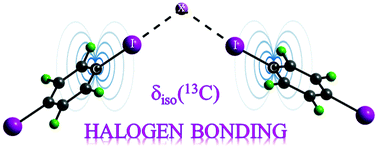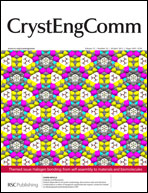The co-crystallization of para-diiodotetrafluorobenzene (p-DITFB) with ammonium and phosphonium halide (Cl− and Br−) salts afforded four new compounds, [(n-Bu4PCl)(p-DITFB)] (2), [(n-Bu4NBr)(p-DITFB)] (3), [(n-Bu4PBr)(p-DITFB)] (4), and [(EtPh3PBr)2(p-DITFB)] (5), that exhibit moderately strong halogen bonding interactions. They have been characterized by single-crystal X-ray diffraction and 13C solid-state nuclear magnetic resonance (SSNMR) spectroscopy in magnetic fields of 9.4 and 21.1 T. The X-ray crystallography shows that in 2, 3, and 4, the halide is ditopic and forms long polymeric zigzag chains, whereas the bromide in 5 forms a dianionic species when involved in halogen bonding interactions. The NMR data, when combined with zeroth-order regular approximation density functional theory (ZORA–DFT) calculations, provide insight into the relationship between the strength of the halogen bond and the 13C isotropic chemical shift. When the carbon–iodine bond length increases, the 13C chemical shift also increases. Further insights into the relationship between halogen bonding and the 13C chemical shifts are obtained through additional systematic ZORA–DFT calculations as a function of the halogen bonding environment.

You have access to this article
 Please wait while we load your content...
Something went wrong. Try again?
Please wait while we load your content...
Something went wrong. Try again?


 Please wait while we load your content...
Please wait while we load your content...